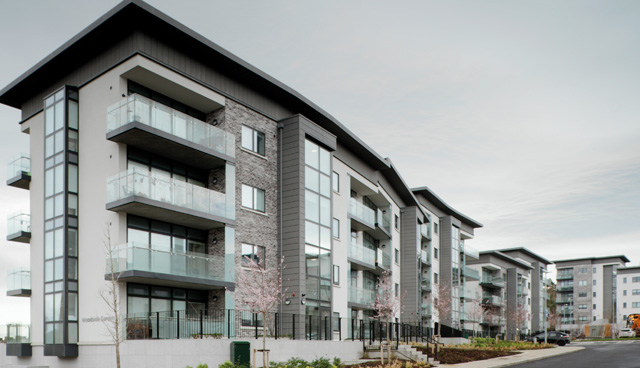
Is it time for radical thinking on housing provision?
18th July 2023
A tipping point for modern methods of construction: Key procurement and contractual issues
18th July 2023Intermediate rent: A new policy

A new affordable housing policy aimed at longer-term rents at least 20 per cent below market value has been geared at increasing housing supply in the North.
The Intermediate Rent Policy, published by the Department for Communities, is tailored towards those earning above the social housing affordability threshold but struggling to access the private rented sector.
Published over two years ago, the draft Housing Supply Strategy set out ambitions to introduce a range of measures to increase the supply of affordable housing. While no Executive has been in place to approve the strategy, significant consultation on it prior to the Executive’s collapse has enabled the Department for Communities to progress some policies, including the Intermediate Rent Policy.
The Intermediate Rent Policy was published and came into operation on 30 March 2023.
Intermediate rent is neither social housing nor open market private rental. Instead, the model recognises that increased social housing supply alone will not be adequate to address levels of unmet housing need in Northern Ireland.
Research done by the UK Collaborative Centre for Housing Evidence for the Department for Communities suggests that Northern Ireland has around 135,000 privately renting households, over a third of whom pay 25 per cent or more of their income in rent. Over 14 per cent of private renters are estimated to be paying 40 per cent or more of their income.
Alongside affordability, security of tenure has been a long-term concern for those in the private rental sector. The Private Tenancies Act (Northern Ireland) 2022 sought to strengthen the rights of tenants in the private rented sector. However, some have argued that an increased onus on landlords does not go far enough.
The Intermediate Rent Policy aims to go some way to addressing both affordability and tenure security, with rents offered at least 20 per cent below prevailing market rents for a similar property type and size within a locality, and tenancies of up to five years at a time, with the option to renew subject to the agreement of the landlord and tenant.
However, the Department has not stipulated how many additional homes it hopes the policy might generate, instead stating that “detail on the number and location of a first phase of intermediate rent homes remains under development”.
Intermediate rent tenancies will still be private rented tenancies but will differ from open market private tenancies in a number of ways, making it a more suitable option for households who can pay more than social rents, but have affordability issues in the open market.
Importantly, the policy is clear that existing occupied dwellings should not be repurposed as intermediate rent.
While it is not intended that tenants have a lifelong tenancy, the policy sets out that intermediate rent homes are intended to remain as such, with a minimum period of 10 years (two consecutive tenancies). There will also be no option to purchase the property at the end of a tenancy.
Funding
Although no funding arrangements have yet been produced, the Department says that it intends to separately provide financial support towards the development and letting of intermediate rent homes, however, in recognising that demand may outstrip supply, the Department has welcomed the development of intermediate rent homes outside of the suggested funding model. Interestingly, the Department states that it will not compel any organisation to deliver intermediate rent.
In a statement, the Department says: “The Department for Communities intends to separately provide financial support towards the development and letting of intermediate rent homes. Work continues to finalise these future funding arrangements. Funding is expected to be made available to an intermediate rent operator who will deliver and let a supply of intermediate rent homes and be awarded funding via a competitive process. The Department will continue to engage with those interested in delivering intermediate rent homes in preparation for awarding funding.
“Subject to budget and approvals, financial assistance in the form of Financial Transactions Capital loan is expected to be made available, alongside a promoter’s contribution, to create a new supply of intermediate rent homes in the future. The Department also welcomes self-funded intermediate rent housing provision.”
The location of intermediate rent homes is not limited, however, it is recognised that the policy may be most effective in areas of high rents and high demand. Alongside the policy, the Department also published a Homes for Intermediate Rent: Design Standards guide, setting out the expected design and finish standards associated with intermediate rent homes.
Eligibility
Single adult applicants for intermediate rent must have an income not exceeding £30,000, rising to a £40,000 ceiling for a two or more adult households, however, it is stated that these homes are not intended to be houses in multiple occupation. The income calculation omits savings up to £30,000, recognising that some tenants may be saving for homeownership, and disability-related benefits, while excluded from a tenant’s income total, can be considered in an ability-to-pay rent assessment.
Initial rent rates of 20 per cent below market value, which cannot change in the first year, if uprated, must remain not more than 80 per cent of market rents for similar properties in the location.
An assessment by the Department states that in line with the policy that a household should not pay more than 30 per cent of their net income on rent, initial intermediate rent rates would be capped at £750 per month for a single adult household and £1,000 per month for a two or more adult household. However, a household may pay up to 40 per cent of their income in “exceptional” and assessed circumstances.
A number of protections for renters of this mode include rent increase, of no more than 5 per cent per year (while still within the 80 per cent of market values range), a nine-month lead in time to tenancy end/renewal, longer term deposit (six to 12 months) payment periods, and provision for prompt and effective repairs by landlords.
On how delivery of the policy will be funded in the absence of a minister, a spokesperson for the Department for Communities said: “Work continues to deliver a funding package which can support the practical delivery of a supply of new intermediate rent homes in the near future.”







